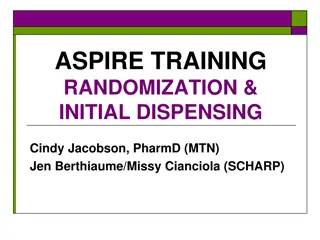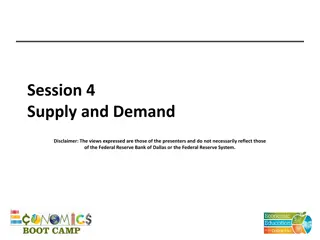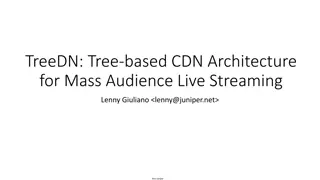Remix: On-demand Live Randomization
This content delves into defense mechanisms against code injection attacks, specifically focusing on techniques like Data Execution Prevention (DEP), Write XOR Execute, Return-oriented Programming (ROP), and ASLR. It explores how these strategies thwart attackers' attempts by randomizing feature space or removing features, ultimately aiming to protect systems from vulnerabilities and unauthorized access.
Download Presentation

Please find below an Image/Link to download the presentation.
The content on the website is provided AS IS for your information and personal use only. It may not be sold, licensed, or shared on other websites without obtaining consent from the author.If you encounter any issues during the download, it is possible that the publisher has removed the file from their server.
You are allowed to download the files provided on this website for personal or commercial use, subject to the condition that they are used lawfully. All files are the property of their respective owners.
The content on the website is provided AS IS for your information and personal use only. It may not be sold, licensed, or shared on other websites without obtaining consent from the author.
E N D
Presentation Transcript
Remix: On-demand Live Randomization Yue Chen, Zhi Wang, David Whalley, Long Lu* Florida State University, Stony Brook University*
Background Buffer Overflow -> Code Injection Attack
Background Buffer Overflow -> Code Injection Attack Defense: Data Execution Prevention (DEP) Write XOR Execute: a block (page) of memory cannot be marked as both writable and executable at the same time.
Background Buffer Overflow -> Code Injection Attack Defense: Data Execution Prevention (DEP) Write XOR Execute: a block (page) of memory cannot be marked as both writable and executable at the same time. Return-oriented Programming (ROP) Attack Discover gadgets from existing code, and chain them by ret instructions Can be Turing complete
Code Reuse Attack Existing Code Chained Gadgets
ROP Defense Strategy ROP is one example of a broad class of attacks that require attackers to know or predict the locations of binary features.
ROP Defense Strategy ROP is one example of a broad class of attacks that require attackers to know or predict the locations of binary features. Defense Goal Frustrate such attacks by randomizing feature space, or remove features
ASLR Address Space Layout Randomization Library1 Library1 Executable Executable First-time Second-time
ASLR - Problem Pointer Leak Library1 Executable
ASLR - Problem Pointer Leak Library1 De-randomized Executable
ASLR - Problem Brute force attacks are still possible (When the entropy is small. E.g., 32-bit systems.) Randomized only once.
Goal Live randomization during runtime Finer-grained randomization unit Low performance overhead Highly composable Can and should be combined with other defenses (traditional ASLR, function randomization, etc.)
Remix Live basic block (BB) (re-)randomization within functions A basic block is a straight-line code without jumps in or out of the middle of the block.
Remix Live basic block (BB) (re-)randomization within functions Advantages: No function pointer migration Good spatial locality A basic block is a straight-line code without jumps in or out of the middle of the block.
Remix Function A Basic Block 1 Basic Block 2 Basic Block 3 Basic Block 4 Basic Block 5 Space for Alignment Other Functions
Remix Function A Function A Basic Block 1 Basic Block 3 Basic Block 2 Basic Block 5 Basic Block 3 After 0.46 seconds Basic Block 4 Basic Block 2 Basic Block 5 Basic Block 4 Space for Alignment Basic Block 1 Other Functions Other Functions
Remix Function A Function A Function A Basic Block 1 Basic Block 2 Basic Block 3 Basic Block 2 Basic Block 5 Basic Block 5 Basic Block 3 After 2.13 seconds After 0.46 seconds Basic Block 3 Basic Block 4 Basic Block 2 Basic Block 5 Basic Block 1 Basic Block 4 Space for Alignment Basic Block 4 Basic Block 1 Other Functions Other Functions Other Functions
Challenges Chain randomized basic blocks together Need extra space to chain basic blocks Need to update instructions Stale pointer migration
Extra Space Case 1: Extra Jmp (1) At the beginning of a function Jmp to BB1 Basic Block 3 Basic Block 2 Basic Block 1
Extra Space Case 1: Extra Jmp (1) At the beginning of a function (2) At the end of a basic block that does not end with an instruction like jmp/ret Jmp to BB1 mov add mov Basic Block 3 Basic Block 2 mov add jle Basic Block 1
Extra Space Case 2: Larger Displacement Before Remix Basic Block 1 Jump to BB3 Basic Block 2 Basic Block 3 Basic Block 4 Basic Block 5
Extra Space Case 2: Larger Displacement Before Remix After Remix Basic Block 1 Basic Block 1 Jump to BB3 Jump to BB3 Basic Block 2 Basic Block 2 Basic Block 3 Basic Block 4 Basic Block 4 Basic Block 5 Basic Block 5 Basic Block 3
Extra Space Case 2: Larger Displacement Before Remix After Remix Basic Block 1 Basic Block 1 Jump to BB3 Jump to BB3 Basic Block 2 Basic Block 2 One-byte displacement: jmp +0x10 Basic Block 3 Basic Block 4 Basic Block 4 Four-byte displacement: jmp +0x00001000 Basic Block 5 Basic Block 5 Basic Block 3
Extra Space Solution With Source Code: Modify the compiler to: 1. Insert an extra 5-byte NOP instruction after each basic block 2. Only generate instructions with 4-byte displacement Enough Space Guaranteed!
Extra Space Solution Without Source Code: With Source Code: Leverage existing NOP paddings: Modify the compiler to: 1. Insert an extra 5-byte NOP instruction after each basic block 2. Only generate instructions with 4-byte displacement Function alignment Loop alignment Can insert random bytes into NOP space after randomization, making attack even harder. Enough Space Guaranteed!
Instruction Update Q: Which instructions need updating ? A: Control-flow related ones, to adjust displacement
Instruction Update Two-step update (e.g., unconditional direct jmp): Step one: Jumps to original address of BB 3 Step two: Jumps to current address of BB 3 Original After BB reordering Basic Block 1 Basic Block 3 Basic Block 3 Basic Block 3 jmp Basic Block 2 Basic Block 2 Basic Block 2 Basic Block 2 Basic Block 3 Basic Block 1 Basic Block 1 Basic Block 1
Instruction Update Direct call: step-one update Indirect call: no update needed Direct jump: step-one and step-two update Indirect jump: discussed later PC-relative addressing: step-one update
Indirect Jump Jump to functions unchanged PLT/GOT Tail/Sibling Call Jump to basic blocks see next
Basic Block Pointer Conversion Why? - Migrate stale pointers to basic blocks, to ensure correctness
Basic Block Pointer Conversion Why? - Migrate stale pointers to basic blocks, to ensure correctness Where? - Return address - Jump table (switch/case) - Saved context (e.g., setjmp/longjmp) - Kernel exception table
Illustration - Return Address main Foo Call Foo Return Site
Illustration - Return Address main Foo Call Foo Return Site
Illustration - Return Address main Foo Call Foo Return Site
Optimization To Speed up the randomization procedure: Pre-store the required information Basic block information (e.g., locations) Code/data that need updating
Optimization To speed up execution: Probabilistic loop bundling Basic Block 1 Basic Block 2 Loop Basic Block 3 Basic Block 4 Basic Block 5
Optimization To speed up execution: Probabilistic loop bundling Basic Block 1 Basic Block 1 Basic Block 2 Loop Bundled BB Bundle Basic Block 3 Basic Block 4 Basic Block 4 Basic Block 5 Basic Block 5
Optimization To speed up execution: Probabilistic loop bundling Basic Block 1 Basic Block 1 Bundled BB Basic Block 2 Loop Bundled BB Bundle Randomize Basic Block 3 Basic Block 1 Basic Block 4 Basic Block 4 Basic Block 5 Basic Block 5 Basic Block 5 Basic Block 4
Optimization To speed up execution: Probabilistic loop bundling Basic Block 1 Basic Block 1 Bundled BB Basic Block 2 Loop Bundled BB Bundle Randomize Basic Block 3 Basic Block 1 Basic Block 4 Basic Block 4 Basic Block 5 Basic Block 5 Basic Block 5 Basic Block 4 The bundling layout is different from time to time. Unpredictable!
Implementation Can work on source code using a slightly modified LLVM, or work directly on binaries. Can work on Linux user-space applications, and FreeBSD kernel modules.
Evaluation - Security Finer-grained randomization: Adds about four bits of entropy to each instruction. Live randomization during runtime: Destroy discovered gadgets immediately after each re-randomization. Software Apache nginx lighttpd Average Basic Block Number per Function 15.3 18.8 14.4 Average NOP Space (bytes) per Function 19.3 26.2 22.1 Want more entropy? Insert more NOP space!
Evaluation - Performance SPEC CPU 2006 Performance Overhead (randomized once)
Evaluation - Performance SPEC CPU 2006 Size Increase
Evaluation - Performance Randomization Time Interval Apache Web Server Performance Overhead (by ApacheBench) Performance depends on hardware speed. Randomization time interval can be random !
Evaluation - Performance Randomization Time Interval ReiserFS Performance Overhead (by IOZone) Performance depends on hardware speed. Randomization time interval can be random !



























